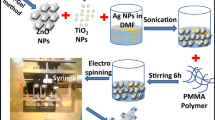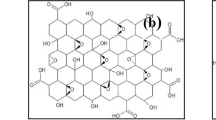Abstract
Capacitive deionization (CDI) with water disinfection materials is an energy-efficient technology for the simultaneous desalination and bio-decontamination of brackish water. However, desalination capacity is always limited by the mechanism of ion electrosorption within the electrical double layer. Recently, the water disinfection ability of CDI has been demonstrated through the functionalization of electrode materials with antimicrobial compounds. To achieve highly efficient and low-cost capacitive deionization and disinfection (CDID) performance, we propose a facile strategy for the fabrication of a graphene oxide/polyaniline/Prussian blue (GO/PANI/PB) nanocomposite. This nanocomposite exhibits a high Brunauer–Emmett–Teller surface area (148.08 m2 g−1), mesopore volume (34.02 cm3 g−1), and pore volume (0.66 cm3 g−1), making it suitable as a Faradaic electrode in the CDI and CDID systems. The obtained GO/PANI/PB electrode exhibits a high desalination capacity of 91.6 mg g−1 and superior desalination ratio of 3.05 mg g−1 min−1 at 1 A g−1. Furthermore, the GO/PANI/PB electrode has a bacterial (Escherichia coli) removal and inactivation efficiency of 94.0% ± 3.1% without the use of other disinfectants. This is ∼7 times higher than the antibacterial efficiency of active carbon electrodes under the same CDI conditions. The proposed strategy is the first to exploit simultaneous deionization and disinfection without using disinfectants, offering the potential of using PB-based Faradaic electrodes for eco-friendly and high-efficiency water desalination and disinfection in future CDID technology.

摘要
具有除菌性能的电容去离子材料对于制备高效节能同时具备脱 盐和抗微生物污染功能的电极材料至关重要, 然而由于双电层电吸附 机制的影响, 多数碳基材料的吸附容量受到限制. 同时, 近年来部分研 究学者通过对电极材料进行抗菌化合物的修饰并用于电容法水除菌已 得到证明. 因此为了实现高效、低成本的同时实现电容脱盐和除菌, 本 研究提出了一种简便的方法制备氧化石墨烯/聚苯胺/普鲁士蓝纳米复 合材料作为类法拉第电极用于电容去离子和水消毒应用. 所合成的电 极材料具有较高的B E T 表面积(148.08 m2 g−1) 、介孔体积 (34.02 cm3 g−1)和孔体积(0.66 cm3 g−1), 在1 A g−1下的脱盐容量为 91.6 mg g−1, 脱盐率为3.05 mg g−1 min−1. 此外, 在未添加额外消毒剂的 情况下, 该复合材料所制备的电极能有效去除和灭活94.0% ± 3.1%的大 肠杆菌, 其杀菌效率是活性炭电极的7倍. 本研究对未来将普鲁士蓝基 复合材料的法拉第电极用于高效环保海水淡化和消毒材料的应用奠定了研究基础.
Similar content being viewed by others
References
Metzger M, Besli MM, Kuppan S, et al. Techno-economic analysis of capacitive and intercalative water deionization. Energy Environ Sci, 2020, 13: 1544–1560
Liu Z, Shang X, Li H, et al. A brief review on high-performance capacitive deionization enabled by intercalation electrodes. Glob Challenges, 2021, 5: 2000054
Wang H, Chen B, Liu DJ, et al. Nanoarchitectonics of metal-organic frameworks for capacitive deionization via controlled pyrolyzed approaches. Small, 2022, 18: 2102477
Zhang P, Fritz PA, Schroën K, et al. Zwitterionic polymer modified porous carbon for high-performance and antifouling capacitive desalination. ACS Appl Mater Interfaces, 2018, 10: 33564–33573
Zang X, Xue Y, Ni W, et al. Enhanced electrosorption ability of carbon nanocages as an advanced electrode material for capacitive deionization. ACS Appl Mater Interfaces, 2020, 12: 2180–2190
Yu F, Yang Z, Cheng Y, et al. A comprehensive review on flow-electrode capacitive deionization: Design, active material and environmental application. Separ Purif Tech, 2022, 281: 119870
Li B, Cao Q, Liu Y, et al. Polyaniline-decorated porous carbons with engineered meso/macrochannels for high performance capacitive deionization. J Mater Chem A, 2022, 10: 24905–24914
Luo Q, Yang Y, Wang K, et al. Hierarchical porous carbon nanofibers for highly efficient solar-driven water purification. Sci China Mater, 2023, 66: 3310–3318
Hu P, Tan B, Long M. Advanced nanoarchitectures of carbon aerogels for multifunctional environmental applications. Nanotechnol Rev, 2016, 5
Qian H, Yang J, Hu B, et al. Partially reduced CeO2/C@CNT with high oxygen vacancy boosting phosphate adsorption as CDI anode. Separ Purif Tech, 2023, 306: 122557
Li Y, Chen N, Li Z, et al. Reborn three-dimensional graphene with ultrahigh volumetric desalination capacity. Adv Mater, 2021, 33: 2105853
Jung Y, Yang Y, Kim T, et al. Enhanced electrochemical stability of a zwitterionic-polymer-functionalized electrode for capacitive deionization. ACS Appl Mater Interfaces, 2018, 10: 6207–6217
Lee J, Kim S, Kim C, et al. Hybrid capacitive deionization to enhance the desalination performance of capacitive techniques. Energy Environ Sci, 2014, 7: 3683–3689
Zhang X, Toledo-Carrillo EA, Yu D, et al. Effect of surface charge on the fabrication of hierarchical Mn-based Prussian blue analogue for capacitive desalination. ACS Appl Mater Interfaces, 2022, 14: 40371–40381
Cool NI, James R, Schofield P, et al. Tunnel-structured ζ-V2O5 as a redox-active insertion host for hybrid capacitive deionization. ACS Appl Mater Interfaces, 2023, 15: 1554–1562
Zhang C, Wang D, Wang Z, et al. Boosting capacitive deionization performance of commercial carbon fibers cloth via structural regulation based on catalytic-etching effect. Energy Environ Mater, 2023, 6: e12276
Wei D, Cao Y, Yan L, et al. Enhanced pseudo-capacitance process in nanoarchitectural layered double hydroxide nanoarrays hollow nanocages for improved capacitive deionization performance. ACS Appl Mater Interfaces, 2023, 15: 24427–24436
Wan P, Xie H, Zhang N, et al. Stepwise hollow Prussian blue nanoframes/carbon nanotubes composite film as ultrahigh rate sodium ion cathode. Adv Funct Mater, 2020, 30: 2002624
Hu M, Dai J, Chen L, et al. Selectivity for intercalated ions in MXene toward a high-performance capacitive electrode. Sci China Mater, 2022, 66: 974–981
Wang X, Wang X, Nian H, et al. Hierarchical MXene/polypyrrole-decorated carbon nanofibers for asymmetrical capacitive deionization. ACS Appl Mater Interfaces, 2022, 14: 53150–53164
Yu F, Yang Z, Zhang X, et al. V2CTx-MXene partially derived hybrid VS2/V2CTx electrode for capacitive deionization with exceptional rate and capacity. J Mater Chem A, 2022, 10: 23531–23541
Gao F, Li X, Shi W, et al. Highly selective recovery of phosphorus from wastewater via capacitive deionization enabled by ferrocene-polyaniline-functionalized carbon nanotube electrodes. ACS Appl Mater Interfaces, 2022, 14: 31962–31972
Shi W, Ma J, Gao F, et al. Metal-organic framework with a redox-active bridge enables electrochemically highly selective removal of arsenic from water. Environ Sci Technol, 2023, 57: 6342–6352
Qie H, Liu M, Fu X, et al. Interfacial charge-modulated multifunctional MoS2/Ti3C2Tx penetrating electrode for high-efficiency freshwater production. ACS Nano, 2022, 16: 18898–18909
Wang L, Yuan Z, Zhang Y, et al. Sandwich layered double hydroxides with graphene oxide for enhanced water desalination. Sci China Mater, 2021, 65: 803–810
Wang L, Zhang P, Chen K, et al. Synthetic subnanochannels in porous aromatic frameworks accelerate selective water permeation in membrane desalination. Sci China Mater, 2022, 65: 1920–1928
Wang Y, El-Deen AG, Li P, et al. High-performance capacitive deionization disinfection of water with graphene oxide-graft-quaternized chitosan nanohybrid electrode coating. ACS Nano, 2015, 9: acsnano.5b03763
El-Deen AG, Boom RM, Kim HY, et al. Flexible 3D nanoporous graphene for desalination and bio-decontamination of brackish water via asymmetric capacitive deionization. ACS Appl Mater Interfaces, 2016, 8: 25313–25325
Wang J, Wang G, Wu T, et al. Quaternary ammonium compound functionalized activated carbon electrode for capacitive deionization disinfection. ACS Sustain Chem Eng, 2018, 6: 17204–17210
Liu N, Ren P, Saleem A, et al. Simultaneous efficient decontamination of bacteria and heavy metals via capacitive deionization using polydopamine/polyhexamethylene guanidine co-deposited activated carbon electrodes. ACS Appl Mater Interfaces, 2021, 13: 61669–61680
Yin X, Li H, Yuan R, et al. General formation of Prussian blue analogue microtubes for high-performance Na-ion hybrid supercapacitors. Sci China Mater, 2020, 63: 739–747
Ye S, Yang X, Huang Z, et al. The activity origin of FeCo Prussian blue analogue for ambient electrochemical hydrogenation of nitrate to ammonia in neutral electrolyte. Sci China Mater, 2023, 66: 3573–3581
Shapira B, Avraham E, Aurbach D. Side reactions in capacitive deionization (CDI) processes: The role of oxygen reduction. Electrochim Acta, 2016, 220: 285–295
Zhao H, Jiao T, Zhang L, et al. Preparation and adsorption capacity evaluation of graphene oxide-chitosan composite hydrogels. Sci China Mater, 2015, 58: 811–818
Guan K, Liu Q, Zhou G, et al. Cation-diffusion controlled formation of thin graphene oxide composite membranes for efficient ethanol dehydration. Sci China Mater, 2019, 62: 925–935
Zheng K, Li K, Chang TH, et al. Synergistic antimicrobial capability of magnetically oriented graphene oxide conjugated with gold nanoclusters. Adv Funct Mater, 2019, 29: 1904603
Shi W, Liu X, Deng T, et al. Enabling superior sodium capture for efficient water desalination by a tubular polyaniline decorated with prussian blue nanocrystals. Adv Mater, 2020, 32: 1907404
Cao S, Chen T, Zheng S, et al. High-performance capacitive deionization and killing microorganism in surface-water by ZIF-9 derived carbon composites. Small Methods, 2021, 5: 2101070
Hatami M, Hosseini SM, Ghorbanpour M, et al. Physiological and antioxidative responses to GO/PANI nanocomposite in intact and demucilaged seeds and young seedlings of Salvia mirzayanii. Chemosphere, 2019, 233: 920–935
Du W, Xiao J, Geng H, et al. Rational-design of polyaniline cathode using proton doping strategy by graphene oxide for enhanced aqueous zinc-ion batteries. J Power Sources, 2020, 450: 227716
Gaikwad MS, Balomajumder C. Simultaneous electrosorptive removal of chromium(VI) and fluoride ions by capacitive deionization (CDI): Multicomponent isotherm modeling and kinetic study. Separ Purif Tech, 2017, 186: 272–281
Agartan L, Hayes-Oberst B, Byles BW, et al. Influence of operating conditions and cathode parameters on desalination performance of hybrid CDI systems. Desalination, 2019, 452: 1–8
Panda S, Rout TK, Prusty AD, et al. Electron transfer directed antibacterial properties of graphene oxide on metals. Adv Mater, 2018, 30: 1702149
Li B, Luo Y, Zheng Y, et al. Two-dimensional antibacterial materials. Prog Mater Sci, 2022, 130: 100976
Shi T, Hou X, Guo S, et al. Nanohole-boosted electron transport between nanomaterials and bacteria as a concept for nano-bio interactions. Nat Commun, 2021, 12: 493
Acknowledgements
This work was financially supported by the National Key R&D Program of China (2017YFA0207202), the National Natural Science Foundation of China (52073230), the Joint Research Funds of Department of Science & Technology of Shaanxi Province and Northwestern Polytechnical University (2020GXLH–Z–013), and the Fundamental Research Funds for the Central Universities.
Author information
Authors and Affiliations
Contributions
Author contributions Li N and Ren P conceived and conducted the experiments, and they analyzed the data with support from Li P; Tian M gave some comments and reviewed the paper; Wang K helped with the TEM and SEM measurements; Saleem A, Liu N, and Yu L analyzed some data; Li P supervised the project; Li N wrote the paper with support from Li P. All authors contributed to the general discussion.
Corresponding author
Ethics declarations
Conflict of interest The authors declare that they have no conflict of interest.
Additional information
Supplementary information Experimental details and supporting data are available in the online version of the paper.
Nan Li received her MS and PhD degrees from Shaanxi Normal University in 2016 and 2019, respectively. Since 2020, she has worked as a post-doc researcher at the Northwestern Polytechnical University (NPU). Her research interests include the synthesis and characterization of organic/inorganic micro-nanomaterials, the separation and enrichment of biological and environmental samples, and capacitive water treatment.
Panyu Ren received her Master’s degree from NPU in 2021. She then started her PhD at Leibniz Institute in Germany. Her research interests focus on the selective ion separation by CDI-based technologies.
Peng Li obtained his PhD degree from Nanyang Technological University (NTU) in Singapore. He then worked as a post-doc researcher at NTU. He is currently a professor and works at NPU. His research covers the synthesis, design, and advanced application of antibacterial materials, the design of medical optoelectronic functional molecules and photodynamic therapy, flexible electronic material and device fabrication, and water purification technology.
Electronic supplementary material
40843_2023_2667_MOESM1_ESM.pdf
Supplementary Information: Prussian blue assembled on graphene oxide for enhanced capacitive deionization and water disinfection
Rights and permissions
About this article
Cite this article
Li, N., Ren, P., Tian, M. et al. Prussian blue assembled on graphene oxide for enhanced capacitive deionization and water disinfection. Sci. China Mater. 67, 143–152 (2024). https://doi.org/10.1007/s40843-023-2667-5
Received:
Accepted:
Published:
Issue Date:
DOI: https://doi.org/10.1007/s40843-023-2667-5




